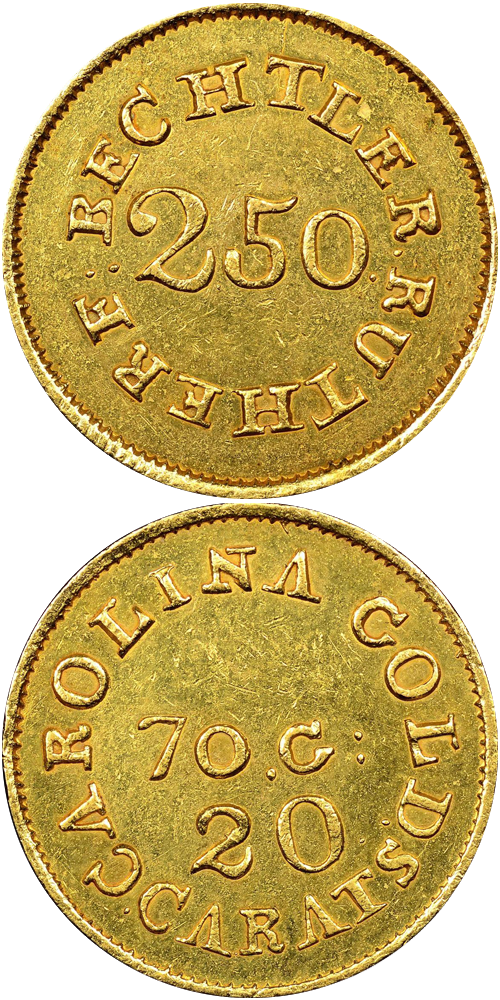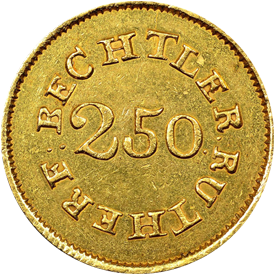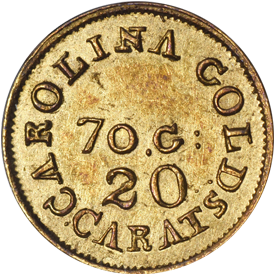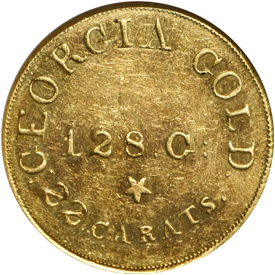During the 1830s North Carolina was one of the most prolific gold-producing districts in the United States. In 1831, for example, $294,000 in North Carolina gold was deposited at the Philadelphia Mint.
Christopher Bechtler, born in Baden, in Germany's Black Forest district in 1782, immigrated to the United States in 1829. He was accompanied by his son, Augustus, who was then aged 16.
In the summer of 1831 , Bechtler, who had received training as a jeweler and was also proficient at gunsmithing and goldsmithing, announced he would receive gold dust and bullion at his Rutherfordton, North Carolina store-residence which he would convert into $2.50 and $5 pieces. Unlike Templeton Reid's venture a year earlier, the Bechtler coinage was well received by local merchants and citizens. His operation furnished a practical alternative to shipping unrefined gold across the long and difficult distance to the Philadelphia Mint for refining and coining.
Another denomination, the gold $1, was coined by Bechtler in 1832. This was the first instance of a gold coin of this value being produced in the United States.
During the 1830s a total of $2,241,850.50 in coins was produced by the Bechtler family, according to a report furnished to the United States government. Coinage was effected from North Carolina as well as Georgia gold. Interestingly, once the government established the Charlotte and Dahlonega branch mints in 1838, Bechtler coinage continued without any interference from the authorities and without any apparent detriment to the private facility. The Bechtler coins were well regarded and were readily used in the channels of commerce even at a great distance from their source.
On June 28, 1834, the United States government enacted legislation reducing the weight of gold in standard coins produced at the Philadelphia Mint. The secretary of the Treasury recommended the inscription "August 1, 1834," the effective date of the legislation, be placed on each gold coin issued after that date. Although this was never done on the federal coinage, Bechtler used the August 1, 1834 inscription on a variety of his $5 issues around that time. Later the inscription was dropped.
In 1837 G. W. Featherstonhaugh traveled through North Carolina. Later his recollections were published by Dr. Thomas Featherstonhaugh, his grandson, in an article entitled A Private Mint in North Carolina, in the March 1906 issue of The Publications of the Southern History Association. The following is excerpted from his article:
After breakfast I walked a few miles to visit a German of the name of Bechtler. I passed a great part of the day with him at his cottage in the woods. He had resided seven years in this country and had established for himself a character for integrity as well as skill in his profession. I found him rather mystical and imaginative, as many Germans are. It was probably this bias that induced him to settle in the gold region of North Carolina. The greater part of the small streams in this part of the gold region have more or less gold in them. Bechtler had obtained some in the usual manner, and having made a die, coined his gold into five dollar pieces. At the period of my visit his gold coin circulated more freely than that of the United States, which were very scarce.
It would be in his power to take improper advantage of the confidence placed in him, but I heard of no instances of his having attempted this. When I mentioned the possibility of this, he answered that it was what an honest man would not do, and that if any man were to do it, he would soon be found out, for the gold did not remain long In circulation, since it found its way very soon to the United States Mint, where It was necessary for him to keep a good character...
Bechtler's maxim was that honesty is the best policy; and that maxim appeared to govern his conduct. I never was so pleased with observing transactions of business as those I saw at his house during the time I was there. Several country people came in with rough gold to be left for coinage. He waited before them and entered it in his book, where there was marginal room for noting the subsequent assay. To others he delivered the coin he had struck. The most perfect confidence prevailed betwixt them, and the transactions were conducted with quite as much simplicity as those at a country grist mill, where the miller deducts [his fee] for the grist he has manufactured...
After Christopher Bechtler died in 1842, the business was continued by his son Augustus. A year or two later, Augustus was apparently succeeded by Christopher Bechtler (known as "the younger"), a nephew of the original coiner. It is believed the Bechtler coinage continued until about 1852.









